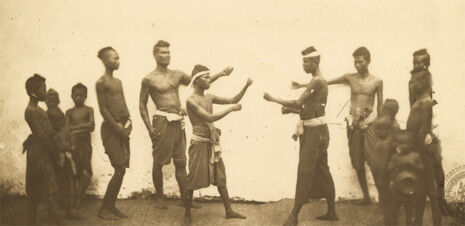Muay Thai: the origins of the Thai boxing sport

The art of Muay Thai, also known as Thai boxing, is seen as a cultural inheritance that was handed down to the next generations. On top of being a combat sport, Muay Thai is also practised for self-defence.
Even though Muay Thai has been around for a very long time, there is not a lot of evidence to support either the origins or their development. Despite that, the development of Muay Thai as a martial art is integral to the history of Thailand in a similar manner to other national martial arts such as Taekwondo for the Koreans.
During a time when Thais fought with nothing more than their swords and bodies, they would have practised their combat techniques by training their body’s movements into the efficient forms of punching, elbows, knees, kicks, and clinches.
In modern times, however, Muay Thai has unfortunately been identified as a form of business where it would become oversaturated with gambling. According to Saranukromthai, the traditional style of the sport is quickly becoming extinct.
Today, we’ll look deeper into the development of Muay Thai, the national sport of Thailand.
Development of Muay Thai
Sukhothai Kingdom
During the Sukhothai kingdom, which lasted from 1238 to 1408, soldiers in the Royal Army practised hand-to-hand combat as a part of their training regime. The practising of Muay Thai, although unarmed, refined their skills and established the fundamentals that the practitioners needed that translated into the use of their weaponry.
Before educating their students on how to utilise their hands, elbows, legs, and knees as weapons, Muay Thai instructors trained their students to become physically stronger through tasks such as carrying water, swinging on vines, and swimming.
It was also during this period that the King’s educational programmes included Muay Thai as one of its core subjects. This was done in order for the King to be braver, stronger, and more able to regulate the country, according to Siam Sport Talk.

Photo courtesy of Saranukromthai (Website)
Ayutthaya Kingdom
The Jaroenthong Muay Thai Gym suggests that the origins of Muay Thai can be traced back to some time between 1445 and 1767 in the Kingdom of Ayutthaya.
In the early days of Ayutthaya, the King granted authorization to men who possessed exceptional skill in Muay Thai to join the army and earn the title of ‘Chosen Soldier’ (Tha Harn Reark). The primary duties of these guards were the enforcement of the order and the maintenance of security within the palace.
Between the years 1604 and 1690, Muay Thai rose to prominence and developed into a viable profession that led to the founding of the first ‘boxing camp.’ Alongside this, the practice of constructing a boxing ring into the shape of a square had begun.
Additionally, boxers fought in ‘Muay Kard Cheuk’ which included the usage of ropes tied around the arms similar in form to modern boxing gloves. This serves as an alternative to bare-knuckle boxing where the rope wraps, usually made with hemp, are designed to protect the hand from impact and allow for more powerful punches.

Thonburi Kingdom
The Thonburi Kingdom did not reign for a particularly long time and only existed for a total of 14 years, beginning in 1767 and ending in 1781.
During this time, the training of Muay Thai was heavily focused towards the Army as they were defending and regaining their territory from the rivalling kingdoms.
Although the spread of the practise of Muay Thai may have reflected the need for the military to protect their kingdom, citizens had ample opportunities to train in this martial art as well. As there were many thieves and robbers during this time, Muay Thai became a martial art that citizens used to defend themselves and their families.
In regards to the competitive aspect of Muay Thai, competitions and fights continued to thrive and were spectated by engaged citizens. However during this era, there were no official regulations for the sport of Muay Thai, according to the Thai boxing initiative,

Rattanakosin Kingdom
In the early years of King Rama 1 to King Rama 5’s reign, the Rattanakosin Kingdom, Muay Thai tournaments were formed and the chiefs of each mueang were granted permission to teach fighters and hold competitions.
In addition, the martial art of Muay Thai became widespread enough that it was incorporated into the curriculum for physical education in the year 1887, allowing school students to train in this martial art as well. According to the Jaroenthong Muay Thai Gym, it is appropriate to refer to the Rattanakosin era as the “Golden Age of Muay Thai.”
It would be correct to call this the ‘Muay Thai golden age’ where the love for the sport became so solidified that even towards the end of World War II, Thais travelled from all over the country to spectate the boxing matches that would continue to be staged at a few theatres. This proved how integral Muay Thai is to the Thai people as they were still heavily invested in the sport during and even after the tragedy that was World War II.

Nowadays, Muay Thai is one of the most popular sports in Thailand that can be seen through the television and media. With a variety of competitions and matches, Muay Thai is plastered everywhere in Thailand and it would be highly unlikely to miss any mention or sighting of anything relating to this martial art.
On top of that, Muay Thai has received immense love abroad where foreigners have travelled to Thailand just to learn it and eventually, Muay Thai has turned into one of the essential core aspects of another form of combat sport called Mixed Martial Arts (MMA).
If you want to explore more about how Muay Thai has had to adapt to an evolving sporting landscape, click HERE to learn more!
Latest Thailand News
Follow The Thaiger on Google News:


























